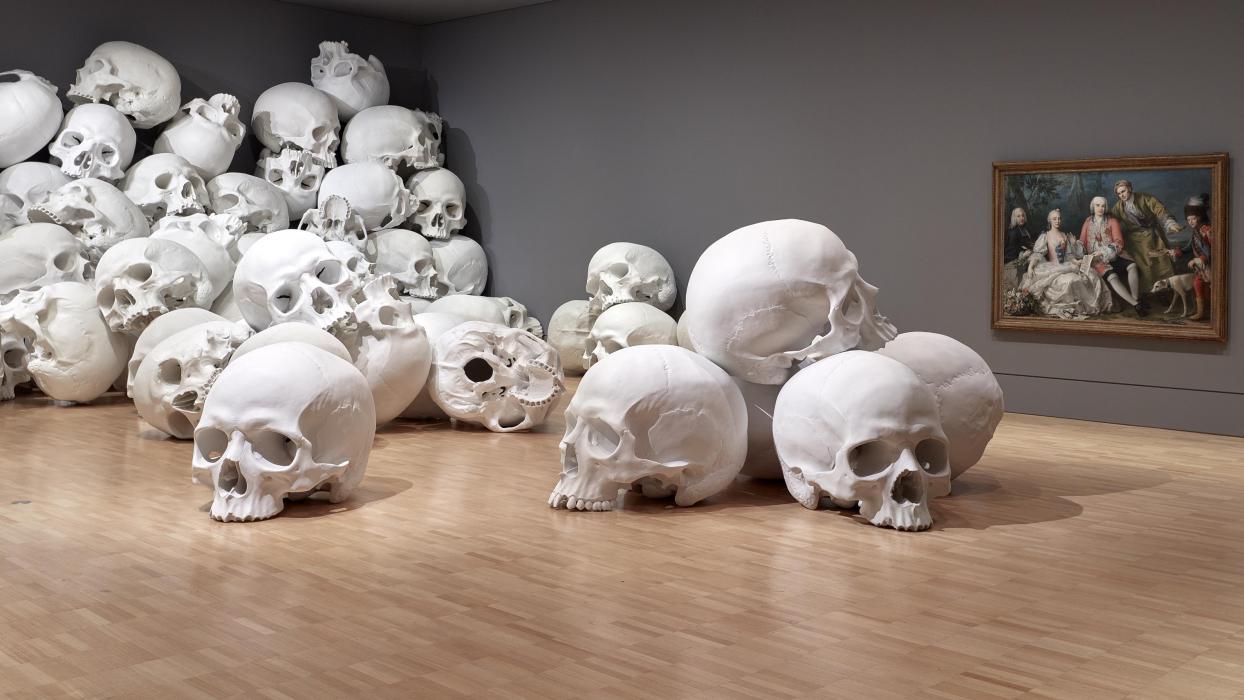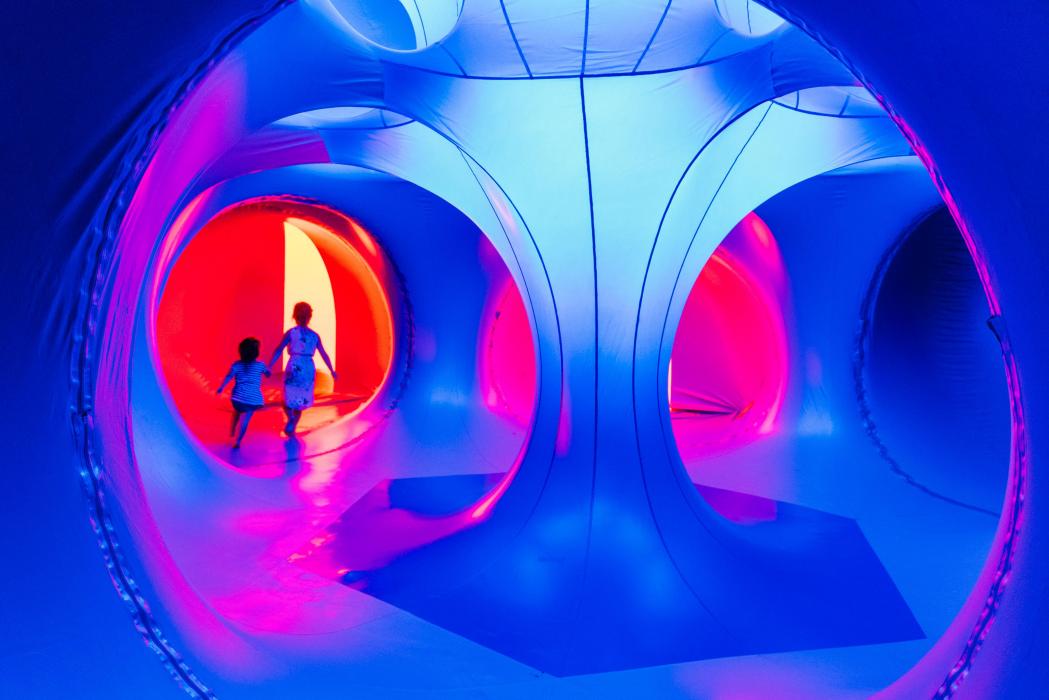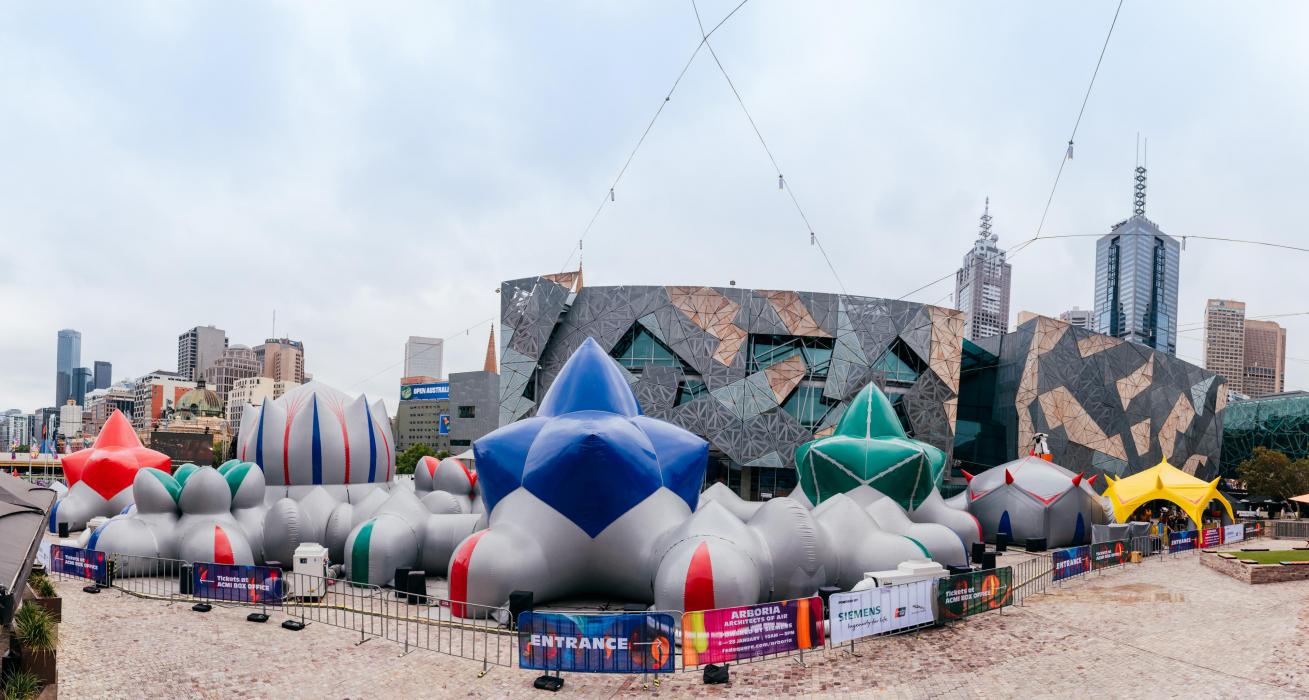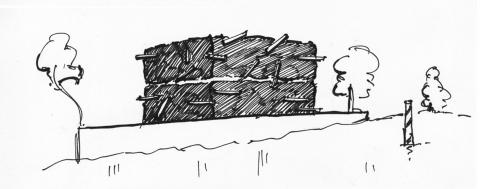What’s still wrong with Relational Aesthetics: teamlab VS Arboria.
The first thing you are bound to notice when you enter the NGV Triennial’s Moving creates vortices and vortices create movement (teamlab 2017) is that it looks almost nothing like the promotion material. What had appeared to be a large calm environment is in fact a small room with mirrored walls creating an illusion of space, which is spoiled by being part of a cramped conga line of viewers urged to keep on moving anticlockwise through the work and straight onto the next triennial highlight. You are likely to feel shortchanged—had you paid you would go and ask for your money back, as the documentation of the work used to promote the exhibition gives a false impression of what you might hope to experience. As you shuffle through the tiny room (clumsily moved in and out of the one door), you may feel you are at one of the NGV’s uber-popular blockbuster shows filing past masterpieces, except that the masterpieces are entirely absent. There are vague swirls of light on the floor, that perhaps shift a little, but there is no time and no space to explore or contemplate this as you are obliged to keep moving along. It may look good on film, but while in the room you may wonder, as I did, what exactly is it that we supposed to be engaged with?
There is always a fine line between subtle over and under demonstration of the relation between movement and image development in such works – here I gained no sense of any play between body and patterned rhythms, nor any attempt to engage the participant in complex embodied perceptual processes. It was, to say the least, underwhelming. If spectacle is what you want, skip this room and go straight to the Ron Mueck, whose room of skulls, which, while completely tasteless (but perhaps not in an entirely good way), at least delivers the wow factor of scale and ambition.
Unlike in some of the early 1960s or 1970s Yayoi Kusama mirrored rooms, the mirroring in Moving creates vortices has none of the folded conceptual or aesthetic logic that made that work so exciting and satisfying (oh to have one of those installations in the Triennial instead of the fun but tame Kusama ‘affix-a-sticker-on-the-wall’ participatory work we are presented with). Here the mirroring seems more like a quick fix: a way to create spectacle (though in fact it fails at this on so many levels) without sparing the space needed for a real sense of immersion in the rhythms of the algorithmic logic at work. Indeed if the aim is to tie real movements to specific developments in the projections in a way that the two might develop symbio-genetically, then this fails entirely: as the movements are duplicated and repeated by the mirrors they lose their spatio-temporal specificity and become a metaphoric demonstration of relation rather than the real thing. Likewise any relationship between ‘nature’ and the algorithmic mutation (a problematic metaphor at any time, denying as it does the potential of an algorithmic aesthetic(1)) is here reduced to a vague representation of something that might look like nature, if you had spent too long indoors and forgotten about the surprising and neverending novelty that the world presents.
Unfortunately on another level the relationships are all too real. That is, the power dynamic created in the work seamlessly mimics the configurations in the general society’s use of surveillance and the neo-liberal instrumentation of bodies, requiring unthinking and unenlightening ‘post-Fordist’ immaterial labour from participants to produce itself. Far from expanding bodily relationships to an artwork or other participants, here bodily potential is organized and reduced. There is no interrogating of the use of these contemporary technologies to constrain and control, no gaps even in the smooth construction in which such questions might arise (as they do at times, for example, in some of Mexican-Canadian artist Rafael Lozano-Hemmer’s Relational Architectures(2)). The normative networks of control are at work here, unquestioned either in relation to uses of technologies or the larger social and environmental context in which such dynamics come to be produced. Here the interfacing between work and viewer is both rigid and productive of normative subject-object relations (no incursions into the workings of the machine are possible). What appears to be an openness of interaction actually produces a strictly linear and distanced experience. As we see again and again in relational aesthetics and interactive works, not only are existing inequalities of relation reinforced, but art is coopted into the invention of new methods of physical and cognitive control.
The deeper level of relational interaction that might include a consideration of the ways that interfaces could be developed in a more open-ended manner, or the interactive and genetic potential of algorithms, doesn’t have a look in here, despite the work that has been done in new media (albeit on the fringes) to rethink such things in the last 25 years. Instead we get an idea of relation built for marketing rather than actual bodily participation, just as the work seems designed more for its photogenic potential than the exploration of the motor-sensory effects of proprioception. Relation here is strategized, stratified and straightened out: don’t you already get enough of that in your day job?
That isn’t to say that I would advocate the kind of politically self-righteous work that Claire Bishop does in promoting Santiago Sierra as an alternate and rigorous version of relational aesthetics. Such work merely taps into another insidious thread of participation, mimicking the power structures of capitalism and imperialism so closely that any claimed critical distance is dubious at best. Surely we can ask more of artworks than that they mimic everyday oppression for the sake of a (largely absent and superficial) ‘debate’.
In search of an antidote to the disappointing aesthetics of teamlab’s work I went off to enjoy my two favourite paintings in the NGV—Manet’s The Melon (c1880) & Philip Guston’s Night (1972)—only to find that they had been benched during the Triennial. However, by wandering down to Federation Square I came across interesting participatory alternative in Architects of the Air’s Arboria, last seen several years ago in the ACCA grounds. This experience at the very least demonstrated an understanding of the term ‘immersive’, and, unlike so much participatory work, there was an aesthetic that rewarded your attention. I don’t know that Arboria was even being promoted as ‘art’: it was billed more as an entertaining experience, which is more honesty than you will find in a dozen relational aesthetics catalogues. At best this might harken back to the at least initially transgressive pre-cinematic panoramas of the C19th, and if these early ‘new media’ experiments ultimately lead us to the abject disappointment of the Oculus Rift VR on show at the NGV with its fuzzy computer aesthetics, old-fashioned task-oriented and unsatisfying functionality and its clumsy-jerky interfacing that succeeded only in inducing motion sickness (all those hundreds of years of experimental painting thrown away just for this!), you can hardly blame the early experimenters. Inside the Arboria what struck me most was the stunning way that the colour saturated and transformed everything, the space and time that one saw people taking to just enjoy, even wallow, in the experience, and the very real connection between the fluctuations in natural light and their effects on vision and colour (best experienced on a sunny day).
It was not a million miles from the work of Robert Irwin or James Turrell—if a day-glo fun-fair version—and unlike at the NGV I didn’t feel at all coerced, instrumentalised or that the work had only its banal technological ‘ingenuity’ to attract, and, again unlike Moving creates vortices, this genuinely did invite and reward viewers of all ages and experiences because it developed an approach to sensation through the aesthetic rather than confused and reductive cognitive philosophies. If, as Brian Massumi and Claire Bishop have separately claimed and seems evident from both the Triennial and the recent Experimenta exhibition at RMIT, both new media and relational aesthetics have largely ignored the radical potential of an experience of aesthetic connection to artwork, and the capacity of such excessive aesthetic experiences to delimit society’s structuring mechanisms rather than enforce them (go read Ranciere, artists!(3)), then in its own modest way Arboria gave a little hope. Ultimately it was hardly a developed work worthy of extended critique, and any of the Impressionist or post-Impressionist works at the NGV do much more with perception, sensation and colour, but at least you didn’t feel like you were in a supermarket aisle or the security line at the airport.
(1) See Luciana Parisi’s Contagious Architecture: Computation, Aesthetics and Space (Cambridge, MA: MIT Press, 2013) for a discussion of the potential of a truly algorithmic aesthetic that neither maps algorithmic thought onto neurological patterns nor reduces ‘nature’ to mere mathematical processes or material computation. Parisi instead asserts the independent agency of algorithms within the world and the concept of an ‘algorithmic thought’ that is not dependent on reference to human thought.
(2) See http://www.lozano-hemmer.com/projects.php?keyword=Relational_Architecture
(3) See, for example, Jacques Ranciere’s The Politics of Aesthetics: The Distribution of the Sensible, New York: Continuum, 2004.

-itok=MgVSiKiE.jpg)
-itok=c2AnquTa.jpg)
-itok=QabDRyS7.jpg)





-itok=bE_wVHXS.jpg)